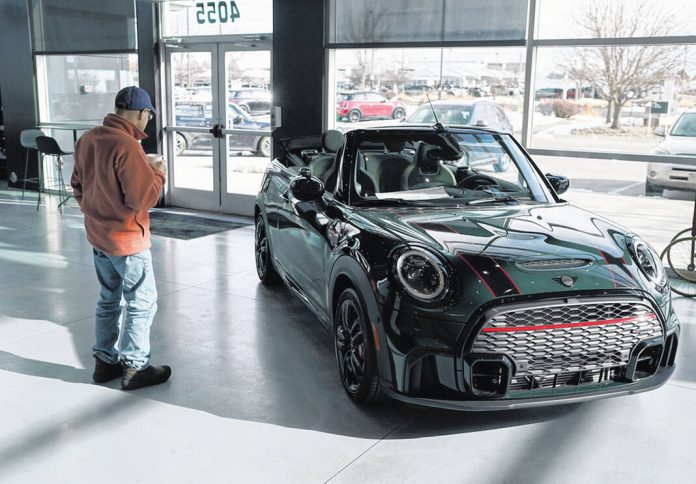
A man looks at a 2024 Cooper S John Cooper Works convertible at a Mini dealership on Nov. 30, 2023, in Loveland, Colo. Automobile prices, which had been fueling inflation in the U.S., are starting to drop, helping to slow overall consumer price increases and giving buyers hope of getting a deal.
AP file photo/David Zalubowski
DETROIT — Price increases for cars and trucks in the United States, which helped fuel inflation for nearly three years, are slowing and in some cases falling, helping cool overall inflation and giving frustrated Americans more hope of finding an affordable vehicle.
Behind the price slowdown is a vastly expanded number of vehicles on dealer lots after years of severe shortages. With more autos available, the pressures that had sent prices surging have eased. At the end of January, American dealers had 2.61 million new cars, trucks and SUVs on their lots, according to Cox Automotive. By contrast, the supply a year ago was just 1.74 million.
Though inventories of new autos are still well below the roughly 4 million level that prevailed before the pandemic, analysts and dealers say the rising availability suggests that 2024 will be the most affordable year of the past five in which to buy a new car or truck.
“When the lots are empty, there’s not much of a bargaining position from a consumer standpoint,” said Glenn Mears, owner of a four-dealership group around Canton and Dover, Ohio. “But now that we have inventory, it’s much more competitive. Much more like it has been historically.”
The price spikes that followed the 2020 pandemic were caused mainly by a worldwide shortage of computer chips, which are vital to auto manufacturing and had forced plants to curb production. As vehicle availability shrank, prices soared. By 2021, some dealers had no new cars at all in stock. Many frustrated buyers turned instead to the used market. The resulting surge in demand for used cars caused those prices to surge, too, elbowing many people out of the auto market entirely.
But with computer chips now abundant, auto production is rising steadily, especially since the United Auto Workers returned to work after strikes last fall.
The average price paid for a new vehicle in the United States fell 1.2% in January from a year earlier, to $47,338, according to data collected by Edmunds.com. That’s down 2.4% from a peak of $48,516 set in December 2022. Though the drop is relatively modest, analysts predict that prices will keep falling this year, especially for new vehicles, as availability grows and automakers are compelled to lower prices.
The average price of a used vehicle — $27,297 as of last month — is down 3% from a year ago and 12% below the peak of $31,095 in April 2022. Analysts expect used-auto prices to fall further before rising slightly once the peak buying season resumes in the spring.
In January, automaker discounts on new vehicles, including rebates and low-interest financing, averaged $1,469 per vehicle — five times what they had averaged a year earlier.
“What we anticipate is that there will be significantly more discounting, more incentives,” said Michelle Krebs, executive analyst for Cox Automotive. “We’re already seeing that.”
When Gary Morrow of Pickerington, Ohio, started shopping for a new SUV earlier this month, he wasn’t prepared to receive any discount at all. But he was pleasantly surprised when Larry Scott’s dealership in Columbus, Ohio, offered a $500 cash incentive, plus a five-year 4% loan — far below the roughly 7% average new-car loan — on a Hyundai Palisade SUV that cost him around $47,000.
“You can’t look a gift horse in the mouth,” said Morrow, a retired teacher. “I was pretty comfortable with the final figure.”
Thanks to the lower-cost financing, Morrow said he managed to keep some money he had set aside for the new vehicle invested, where he hopes it will deliver a higher return than the rate on his 4% loan.
New vehicle prices didn’t rise at all from December to January, government figures show. Still, they’re up more than 21% since the start of 2020, when the pandemic erupted and triggered severe parts shortages. For used vehicles, the average price dropped 3.3% last month, though at just over $27,000 it remains 32% above the pre-pandemic average.






